With over 7 million people, Amsterdam is the Netherlands’ largest city and most populous urban area. Rich with history it also has a vibrant present. Millions of tourists flock to see the picturesque canals and unique architecture, but one thing you hear little about is the food. Many people don’t think Dutch food is much to write home about, but I’m here to say different! While I will admit the food scene is probably not on par with say Italy or France, there are still lots of extraordinary food items to try to tick off your bucket list! Plus, unlike other European capitals, these traditional food items are super cheap! This means eating the local cuisines is easy to do on any budget!
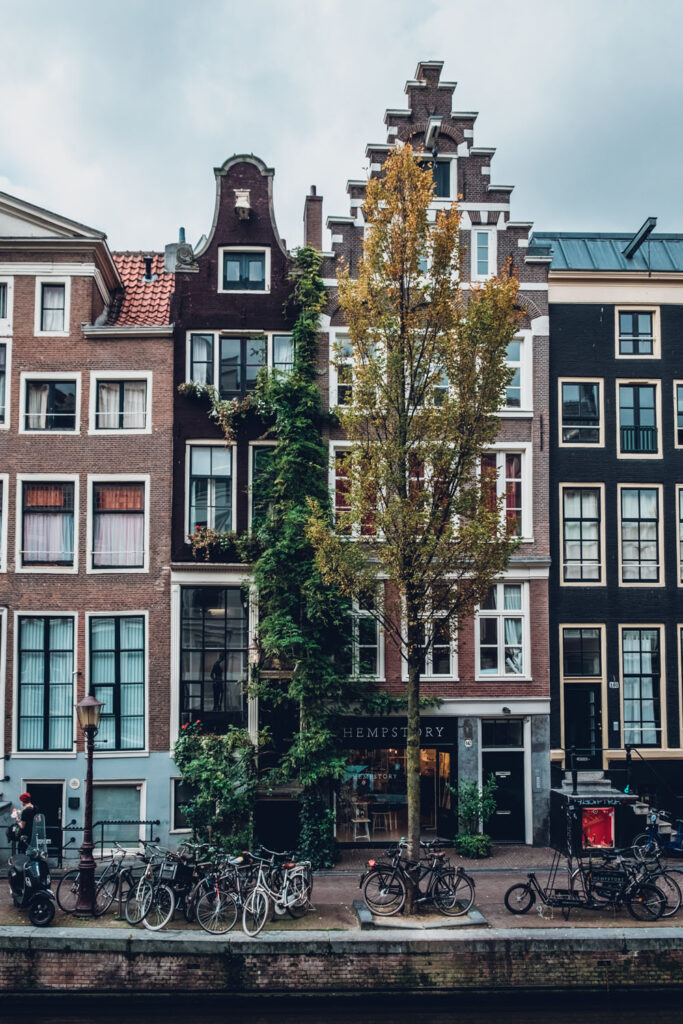
Stroopwaffels
Stroopwaffels are my top Dutch treat! There is no competition. Stroopwaffels are wafer-thin cookies with a layer of ooey-gooey caramel syrup layered in between. The dish was invented in nearby Gouda, but the Amsterdam chefs perfected the recipe. The best way to eat then is to hot off the griddle. You can find Stroopwaffel stands all over the place but especially in marketplaces. When they are free the waffle is still slightly bendy, and the caramel in the center is almost runny. Sounds messy but its honestly the best way to eat them! Just grab some napkins.

Although stroopwafels are inarguably delicious, my affinity for the cookie is also very personal and hilarious. When I left Amsterdam I bought a large package of Stroopwaffels to bring home to my family. After travelling for hours, I arrived on the Danish island of Aero, only to find every single restaurant was closed. And I hadn’t eaten all day! Thankfully I had my Stroopwaffels to keep me satiated until the next morning. Even now, when I eat them, I get a warm and fuzzy feeling remember that night in Aero. These prepackaged cookies are great for souvenirs too, not just to scarf down in the middle of the night! Dip them in your coffee in the morning to keep memories of your trip alive long after you get home.

Pickled Herring
Pickled Herring is one of the most famous items people will tell you “you must eat,” while in Amsterdam. Before you turn your nose up at it, try thinking of it simply as the “sushi” of the Netherlands. The shallow coastlines around Amsterdam are the preferred breeding ground for schools of tiny herring. Fishermen for hundreds of years have been throwing their nets offshore to bring in piles of delicious fish. Dutch fishermen learned early on that they could salt the fish to preserve it. Not only did this allow the fish to keep in the pantry for longer, but it also meant they could transport it for sale across Europe in the middle ages. A huge financial boom for the Dutch economy.
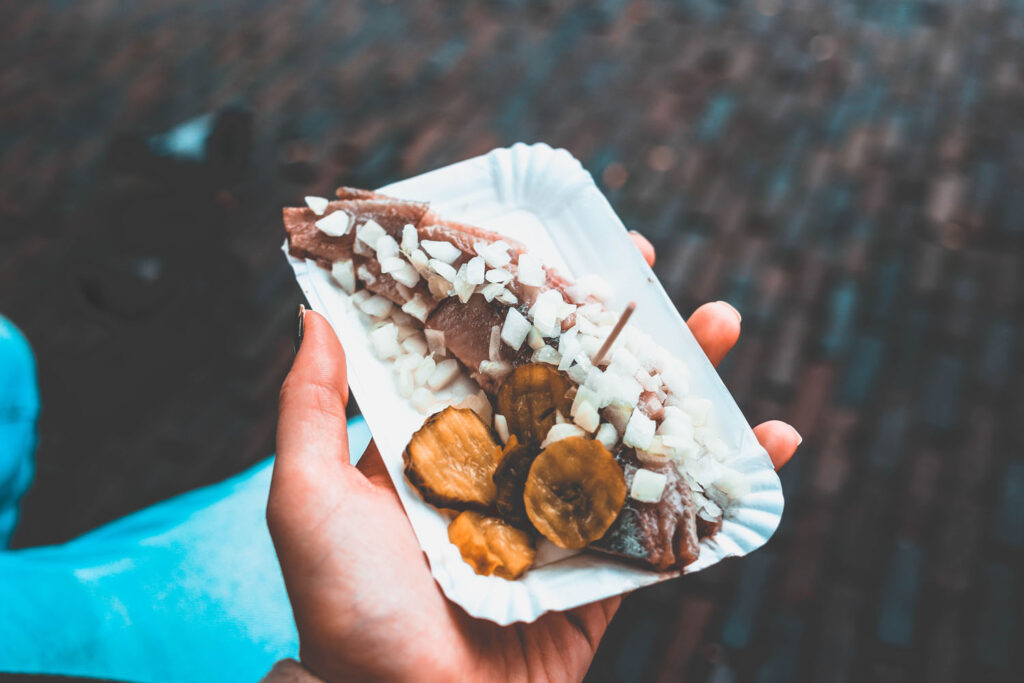
The best way for newbies to try the dish is as Broodje Haring (or a Herring Sandwich.) The pickled herring is sliced thinly and served on a soft bun covered in pickles and onions. The fish pairs perfectly with the onions and pickles and make for a delicious cold summer sandwich. Of course, some people eat the herring without the bun, but they never forget the pickles and onion!
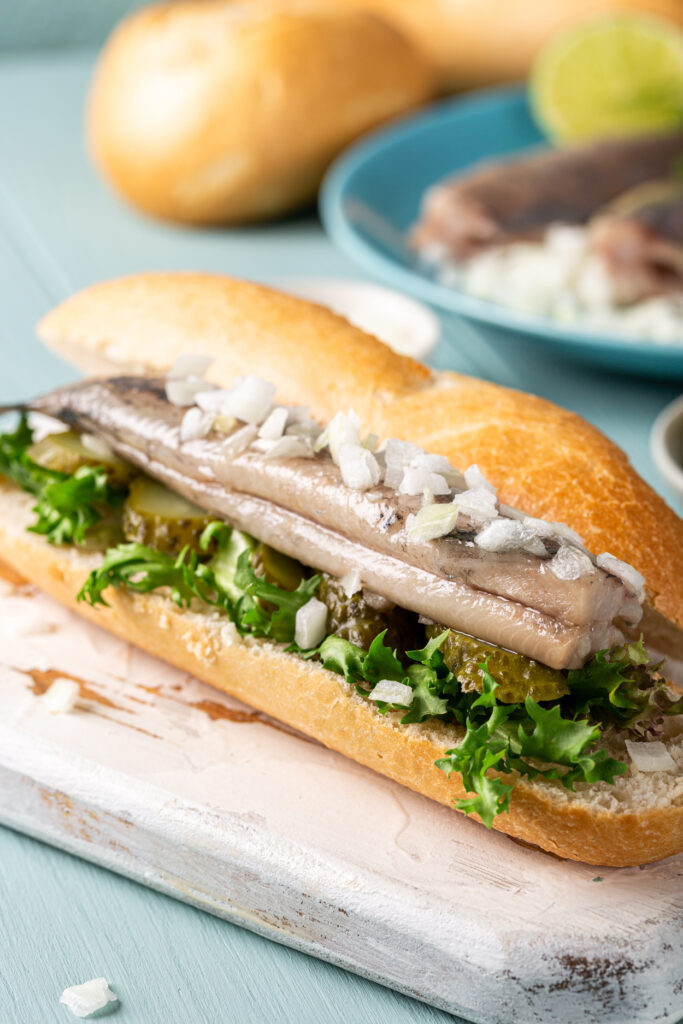
Bittenballen
Bitterballen are small fried balls of beef ragu. Biting into them releases the oily sweet and salty meat hidden inside a lightly breaded crispy exterior. It is one of the countries favourite snacks and perfectly paired with a pint of beer and a huge side of mustard. The word “bitter” means beer, and “ballen,” well, of course, means balls. So they are, in fact, beer balls. Be careful eating them hot from the kitchen as the molten hot center can burn your mouth if you try to down them too quickly.
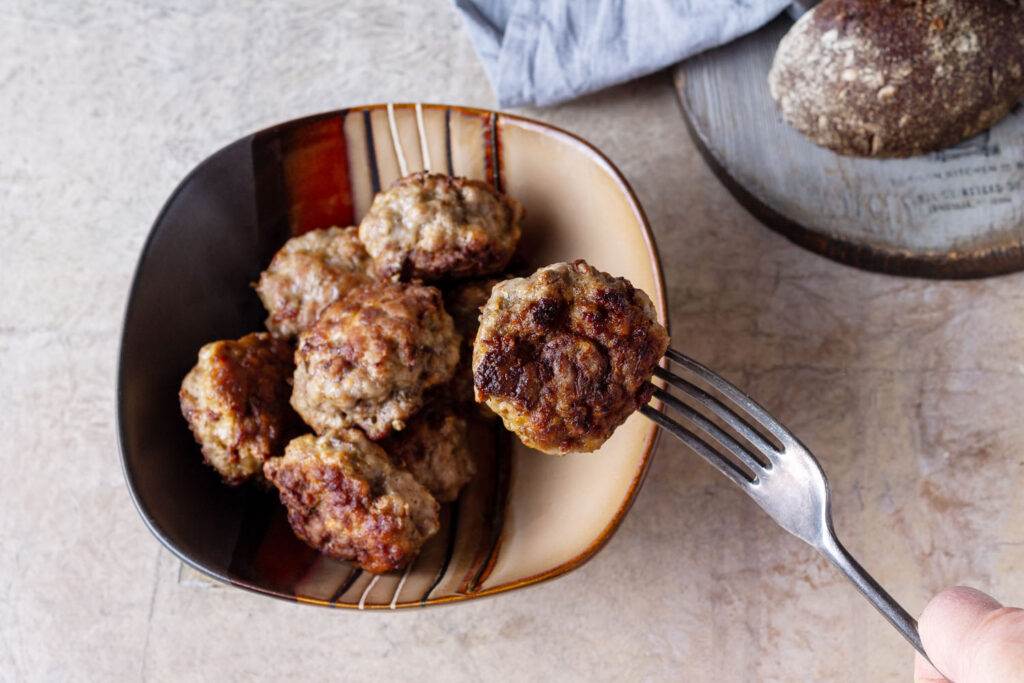
Cheese Tasting
While Gouda is the most popular name in cheese in Amsterdam, it is certainly not the only variety. Gouda was first recorded as being manufactured in the Netherlands in 1184! This makes it Europe’s oldest cheese type. One of the reasons that the name “Gouda” is so well known is not just because of the taste. But also because of the town for which it is named after; Gouda. In the middle ages, the town of Gouda was given feudal rights on cheese markets. Feudal right meant that Gouda was the only place in the Netherlands where cheese was allowed to be sold. Essentially giving the city the monopoly on the market. As a result, every farmer would bring their cheese to the Gouda city market square. And once a week, buyers would meet here to haggle on the best prices for cheese from around the Netherlands.
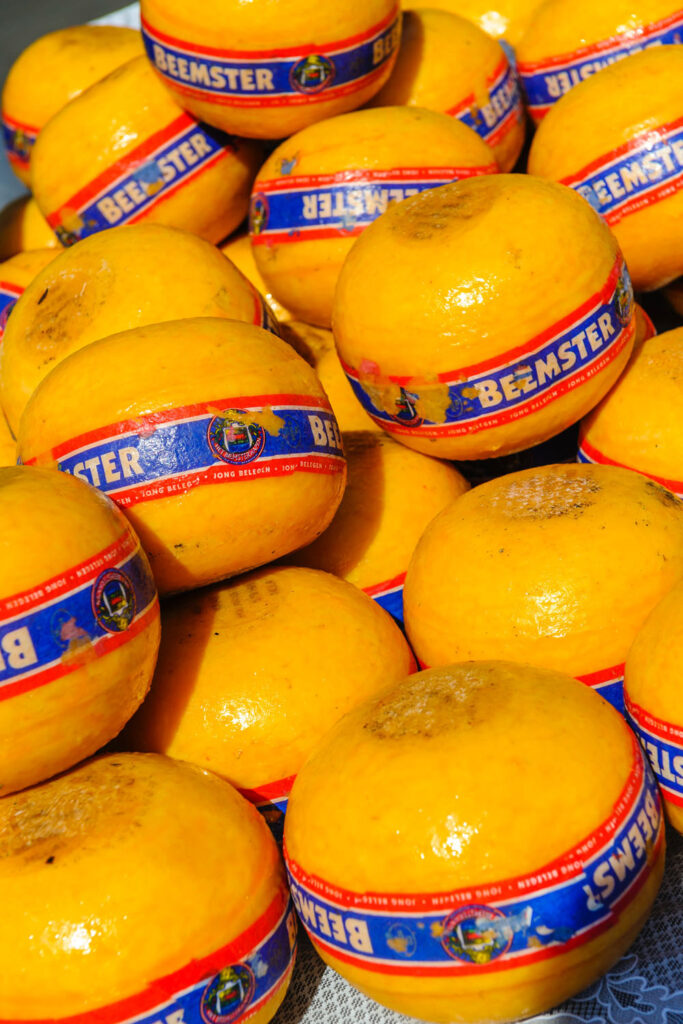
To get some in-depth knowledge about cheeses from the Netherlands, you should try to book a cheese tasting. Skip the so-called “Cheese Museum” as this tourist trap is far from serving up the good stuff. Instead, head to the Fromagerie Abraham Kef. Abraham Kef was a pioneer of cheese in Amsterdam. He opened his shop here in 1953. Ever since he has been serving his customers only the best from local farmers and a smaller selection of international cheeses as well. You can book a cheese tasting to explore a variety of fantastic artisanal cheese served alongside cold cuts, exquisite wines and seasonal beers. All these parties make the taste of the cheese come alive in a different fashion and make for such a better experience.
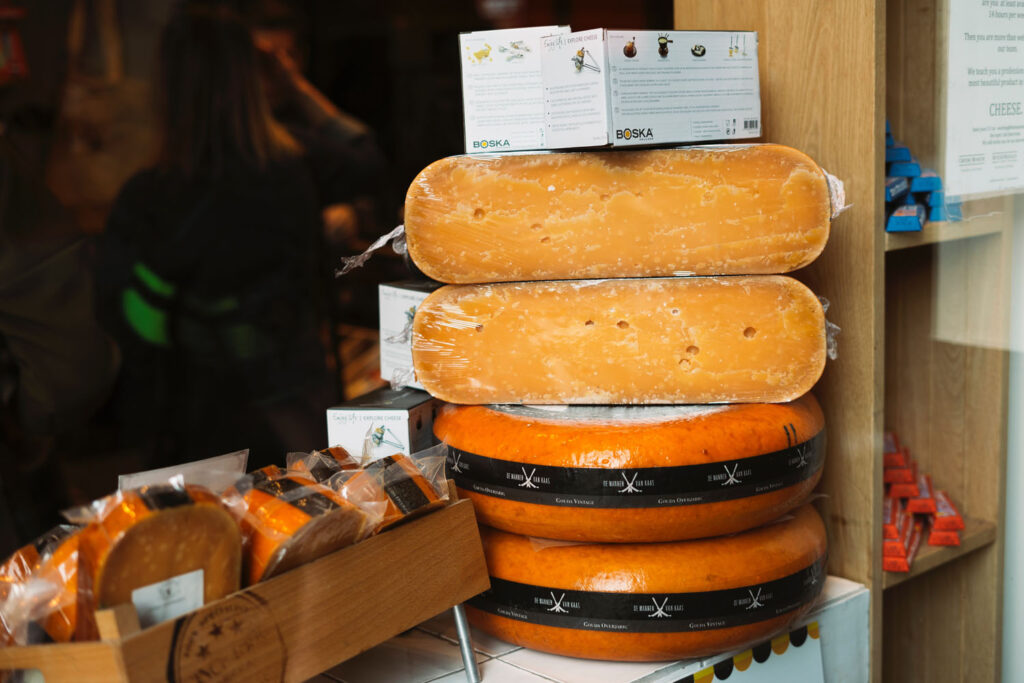
FEBO
Long before I visited Amsterdam, I had read all about FEBO. While in school I was tasked to write an essay on the history and modern incarnations of vending machines. And while researching, the name “FEBO” came up again and again. So when I finally got the chance to travel to Amsterdam, I was so excited to finally visit this shop.
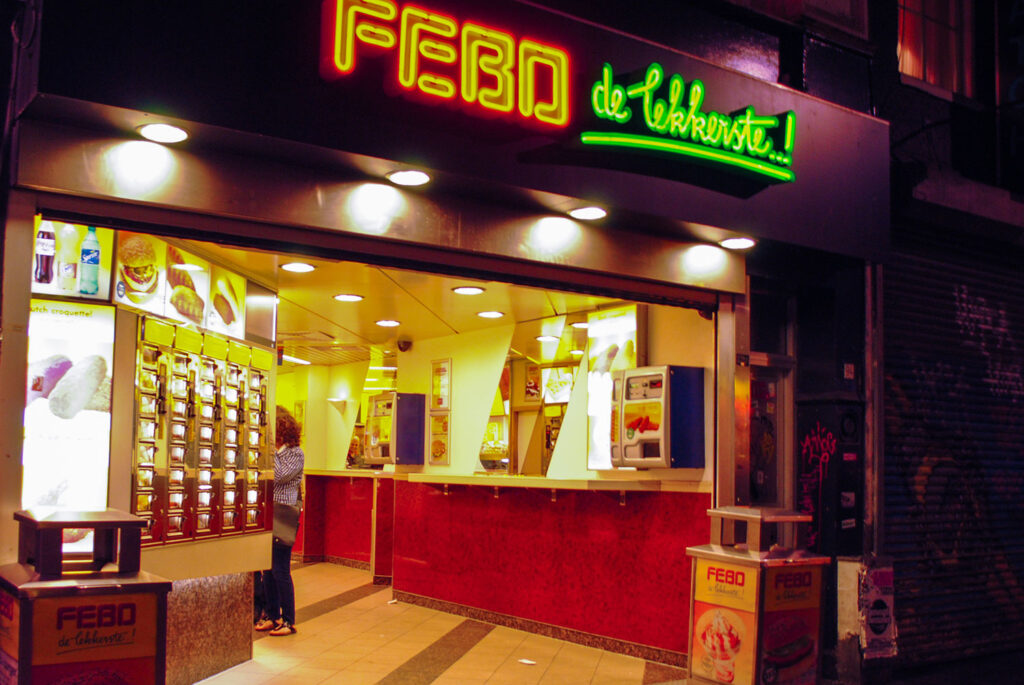
While FEBO looks like a modern, trendy innovation, it is over 50 years old! The shop opened in 1941 as the first “automat” restaurant in the Netherland. Automats had caught on around the rest of the world, starting in Germany in 1895. Originally named Quisisana, these fast food vending machines could operate 24 hours a day and didn’t need front counter staff. Instead, the food would be loaded into the warming machines from the back kitchen. Then customers only had to place a coin in the slot to open up the machine to access the food within.
To this day, FEBO serves up popular Dutch fried food like krokets, frikandellen, hamburgers, Kaassoufflés, french fries and more. The machines still work just as they did in 1941. The retro look, in addition to the addictive food, is what keeps people coming back! Don’t worry about the food not being fresh, each of the items are thrown away if they are not consumed within the hour.
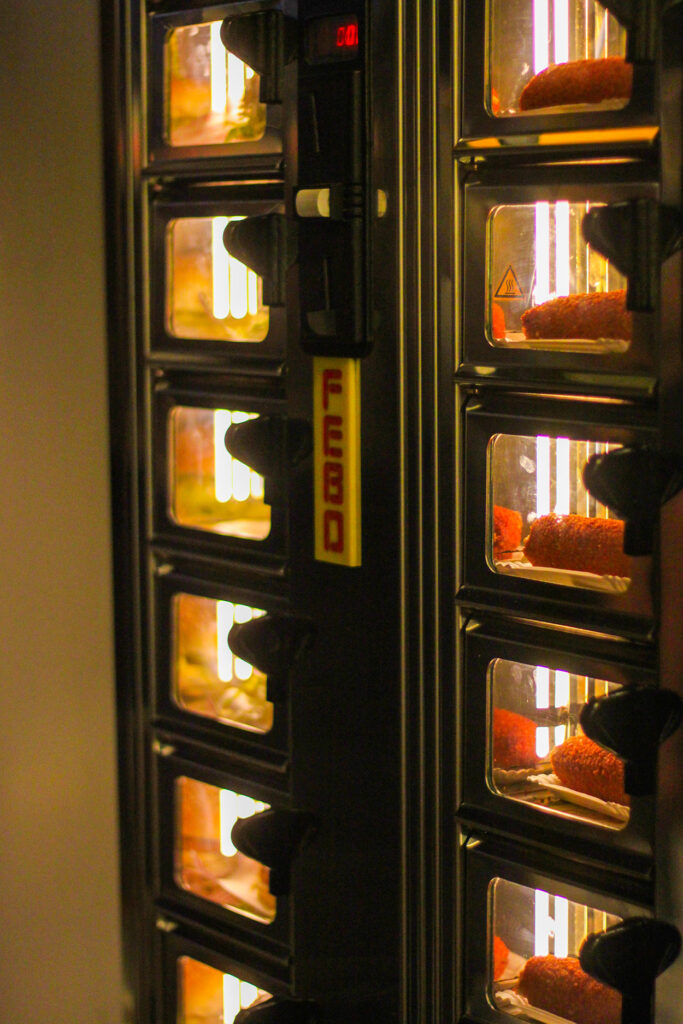
Kroket
If you are visiting FEBO, make sure you try their Kroket. The kroket is a Dutch delicacy made from meat covered in breadcrumbs and then deep-fried. The most traditional type of meat would be beef or veal, but a popular variety is also shrimp or even chicken satay! Sometimes kroket are served with white bread or buns to sop up the greasy and are best paired with a dollops of mustard!
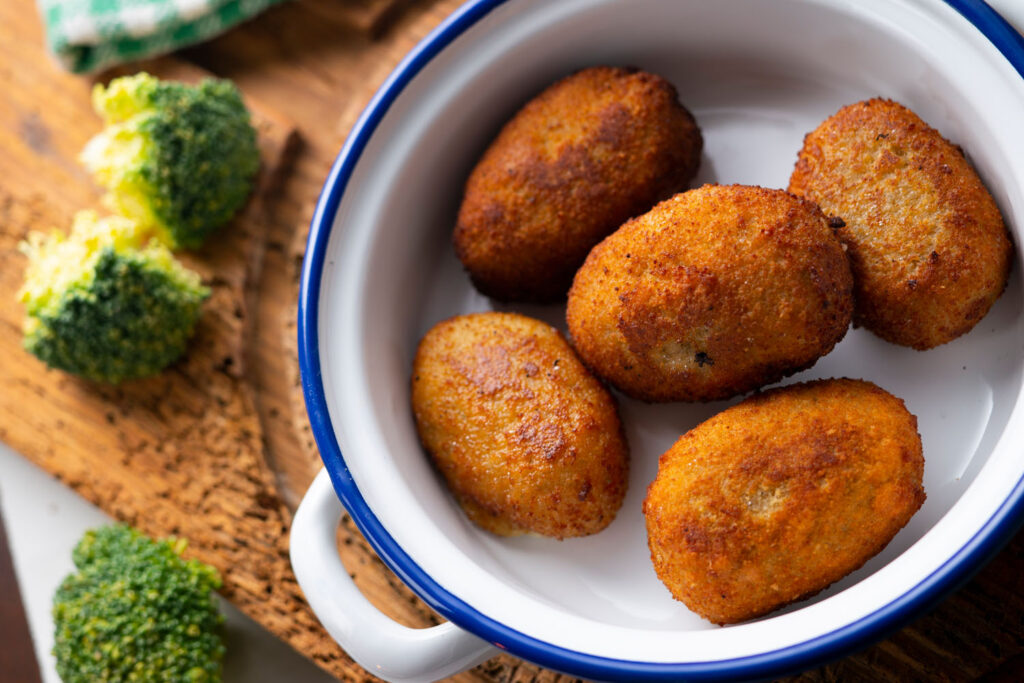
Kapsalon
Kapsalon was first invented in Rotterdam in 2003, but the cheap and highly filling fast food caught on like wildfire in Amsterdam. It is the perfect post-drinks food to prevent a whopping hangover. This isn’t item haute cuisine, but it’s more than worth checking out as locals swear by it! The dish consists of a layer of french fries covered in melted gouda, topped with gyro meat, green salad, garlic sauce, and sambal! Samal is a variety of hot sauces originally brought back from the former Dutch colony of Indonesia. Sambal is found in almost every fridge in Amsterdam so you need to make sure you get this topping. While Kapsalon is a hefty 1800 calories per dish, it makes for a great sharable meal!
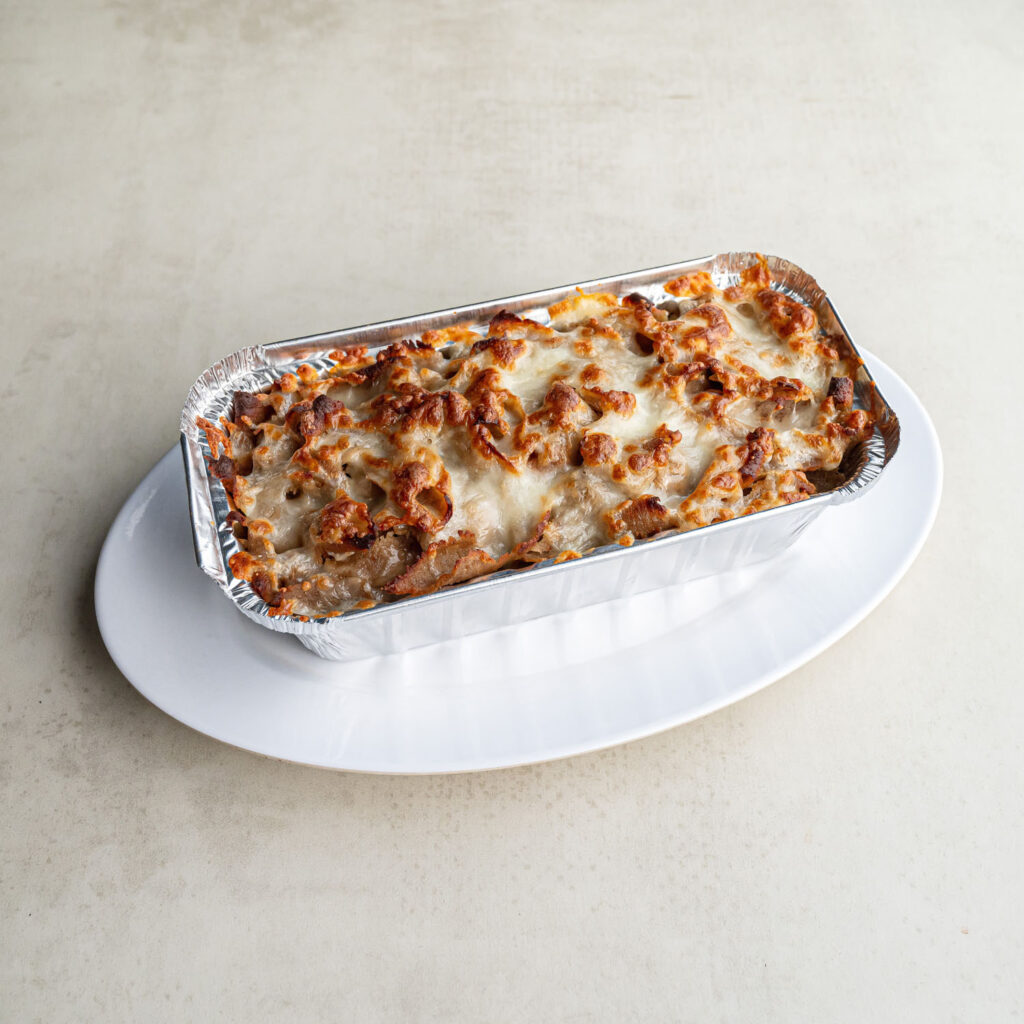
Pannekoek
Pannekoek, or Dutch Pancakes, are one of the most customizable meals you can get in Amsterdam. No matter what you like, there is a pancake out there for you. Even Gluten-free and dairy-free diets are taken into account at places like Pancakes Amsterdam! Pannekoek is nothing like our North American pancakes. They are large, the size of a large dinner plate. The batter is spread thin but not quite as thin as a French crepe. Then you can add everything from apples, syrup, cheese, ham and more into the batter while your Pannenkoek cooks. They can be rolled up to be eaten on the go or served with a fork and knife while relaxing at the table. Although we might think of Pannekoek as breakfast food, these inexpensive and filling pastries hit the spot any time of day!

Dutch Fries
While it’s true that French Fries come from Belgium, the Dutch have perfected it. Dutch fries are thick-cut; short and stubby. They come served in a paper cone and topped with more than just ketchup. The Dutch are obsessed with condiments, and this is a country after my own heart. Half my fridge is just condiments so walking into a fry shop here and being met with a wall of condiments was music to my ears. Everything from mayo, peanut sauce, curry ketchup (my fave) and the previously mentioned sambal hot sauce can be added onto your pile of potatoes.
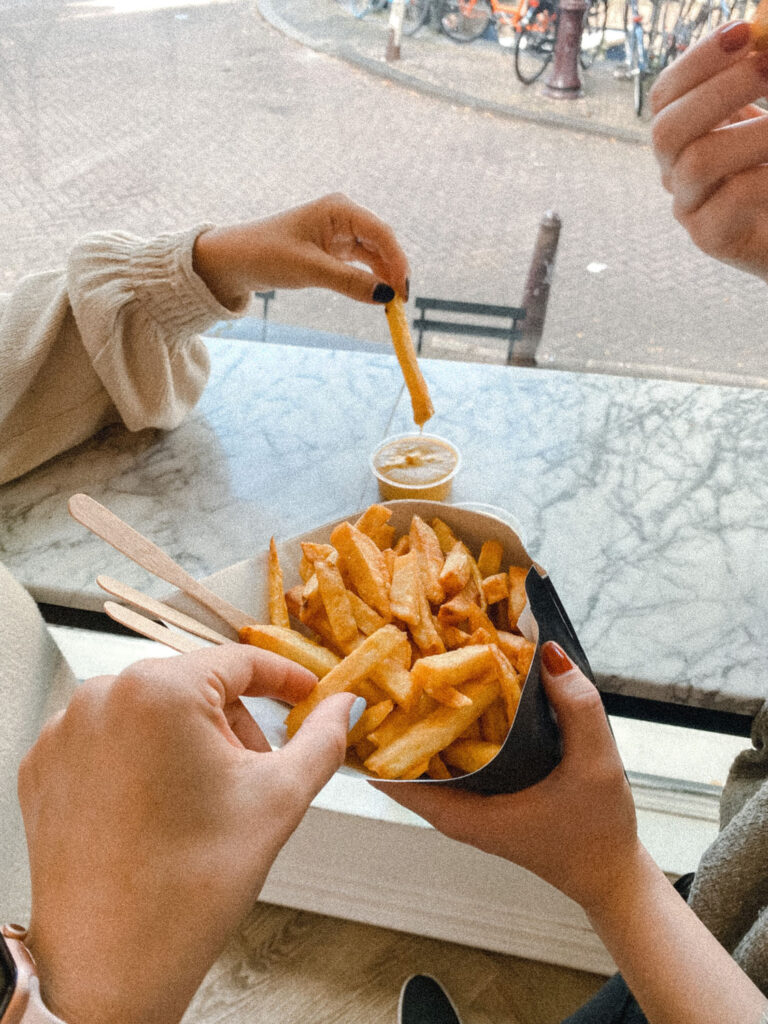
Appeltaart
Appeltaart is Dutch apple pie and is like American apple pie turned up to eleven! Pie is truly NOT an American invention, and the Dutch have been serving up slices for centuries. The Appeltaart is baked in a springform pan to allow the crust to climb up high up to contain the mountains of thick apple slices. The crust is crumbly and perhaps more like a cake batter than a pie crust. The filling is drier than the North American apple pies. Added to the recipe is lots of cinnamon and always accompanied by a shot of rum or brandy.
The recipe dates back to 1514, and the dessert was so popular it was even portrayed as early as 1626 in still life paintings. The dessert is often served with a large dollop of whipped cream and pairs perfectly with a warm cup of coffee. Be European and eat pie for breakfast!
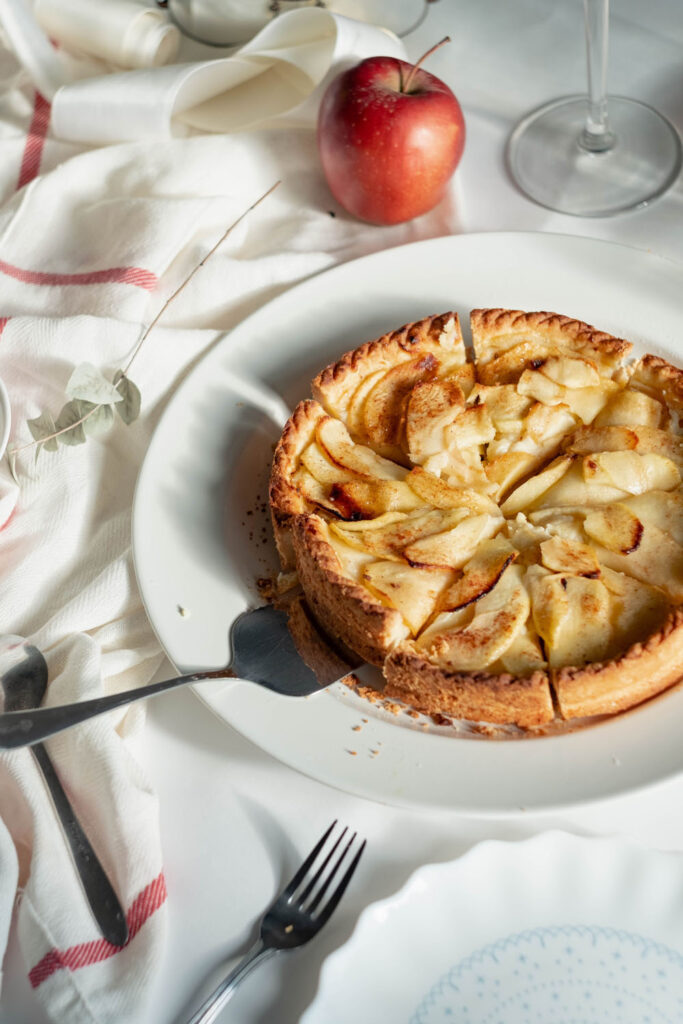
Brown Cafes
Although this isn’t technically food, your foodie experience in Amsterdam is complete without visiting a Brown Cafes. Bruin cafés, aka brown cafes, are a staple in any Dutch city. The name comes from the fact that these old bars would have walls stained brown from the tobacco smoke. Layered after years and years of smoking patron drinking long into the evening. To hid the smoke-stained, many of these bars covered the walls in dark wood which would hide the smoke and they are always dimly lit. These days, thankfully most bars have banned smoking inside. But the idea of the brown cafes continues today with pubs filled with eclectic vintage furniture, ambient atmosphere and of course, great food and drinks! Brown Cafes are a great place to grab a local draft beer while enjoying the sound of locals chatting amongst themselves.
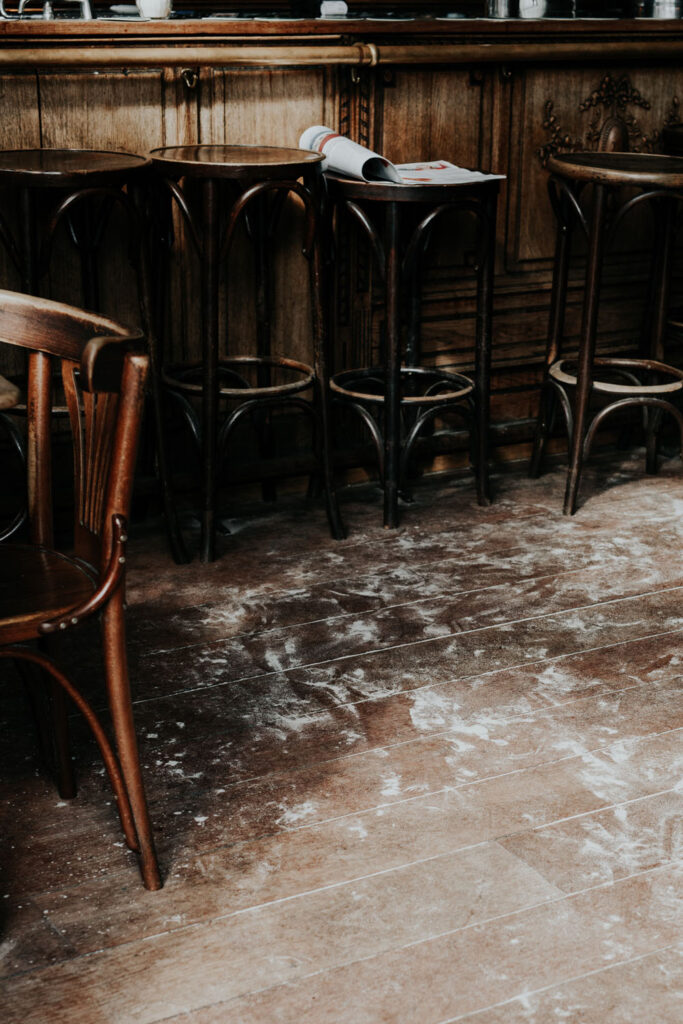
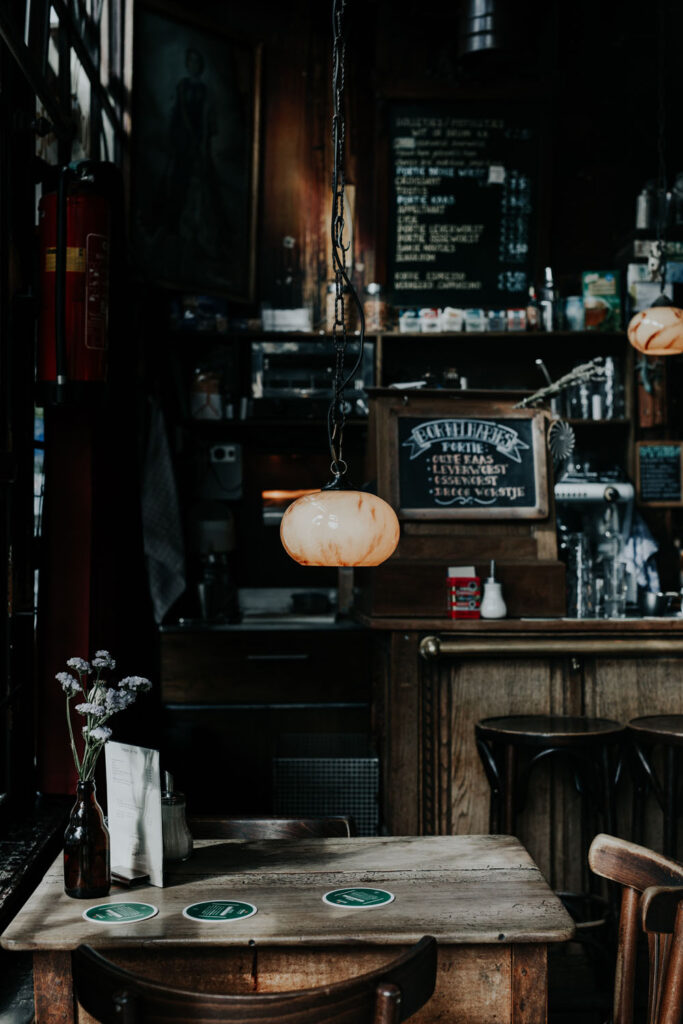
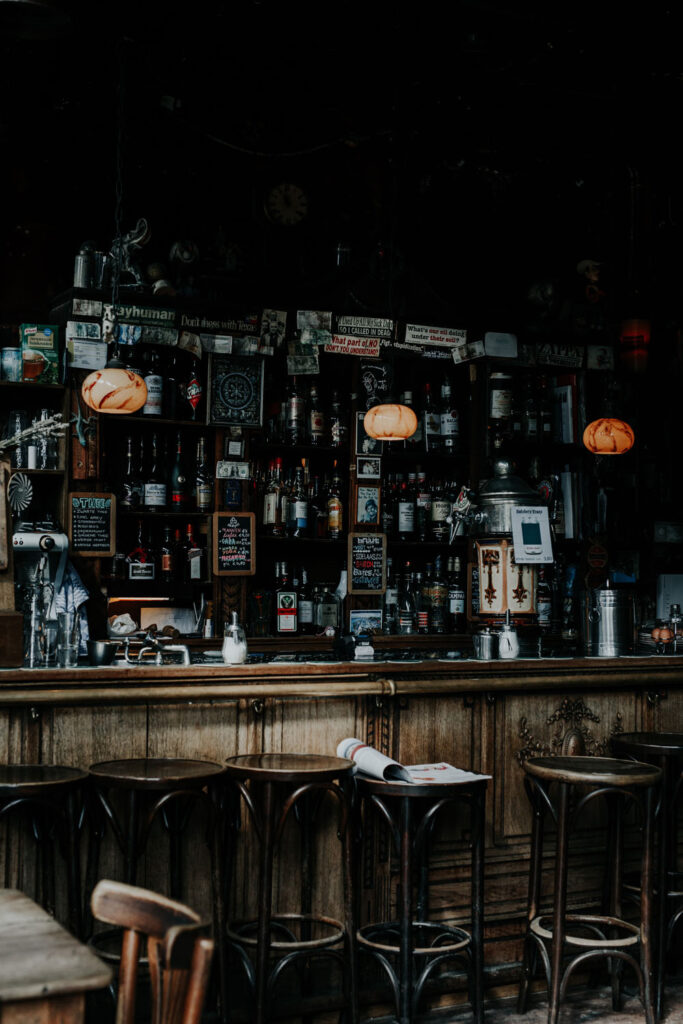
Jenever
If beer isn’t your thing, then you should ask the bartender for a Jenever. Jenever is a distilled spirit similar to gin, made from juniper berries but has a slightly different flavour as the original recipe included lots of medicinal herbs. Originally it was formulated in pharmacies as a curative drink that was thought to aid in digestion and inflammation. It is one of the country’s signature drinks and comes served inside a cute tulip-shaped glass. Many people love to enjoy a glass of jenever alongside a slide of herring.
Rijsttafel
Indonesia was once a colony of the Netherlands back in the middle ages. One of the favourite imports Dutch travellers brought back with them was Indonesian spices and cuisine. More and more immigrants from Indonesia came to the Netherlands and over the years they began opening up restaurants. One of the most famous types of meals to eat is Rijsttafel. Rijsttafel means “the rice table.” A pretty good description as the meal consists of various meats, veggies, and fish dishes, all served atop beds of steamed rice. And when I say “a variety,” I mean a HUGE variety. Some restaurants serve over 40 different dishes with their rijsttafel meals. As someone who loves to try a little bit of everything off a menu, this is my dream kinda cuisine. And a nice break from all the fried Dutch food.
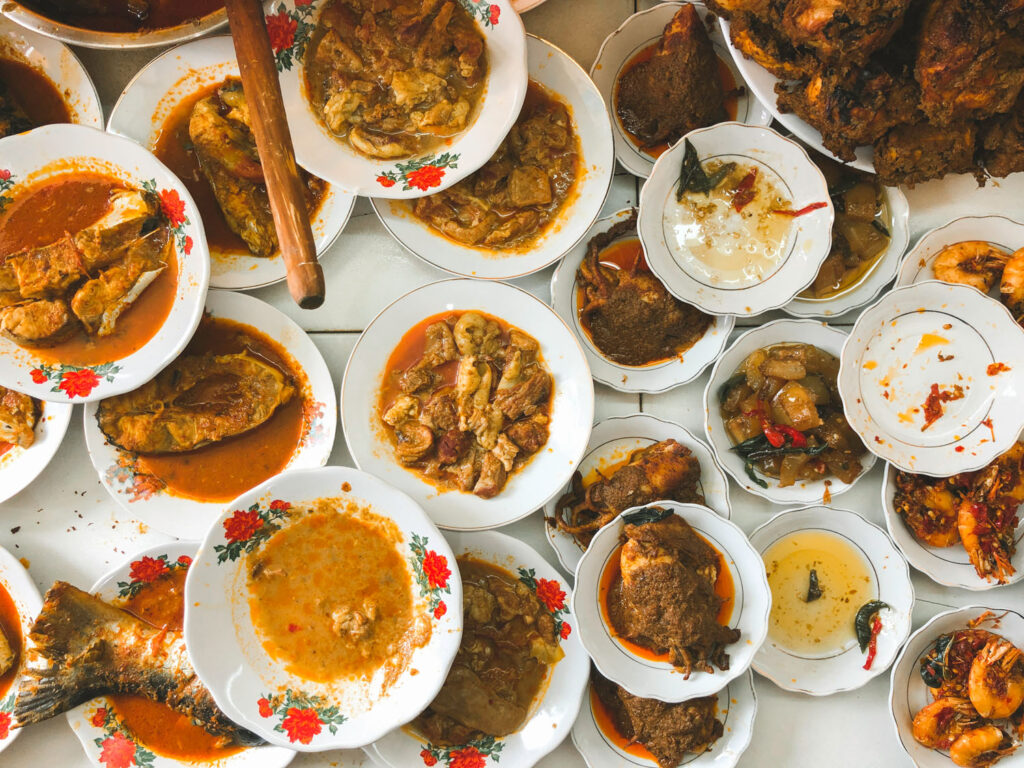
Spekkoek
Another dish originally from Indonesia is Spekkoek. Spekkoek has cemented itself into the heart of Dutch people and is one of the best bakery items to pick up and enjoy while picnicking in the park. The dessert is made of multiple layers of cake made with a mixture of Indonesian spices. Each thin layer of cake is separated with another thin layer of cream. The cake’s name comes from the words “spek,” which means fat and “koek” which means cake. So it translates to “fat cake.” This is because the different light and dark layers of cake and cream are thought to resemble a strip of fatty bacon!
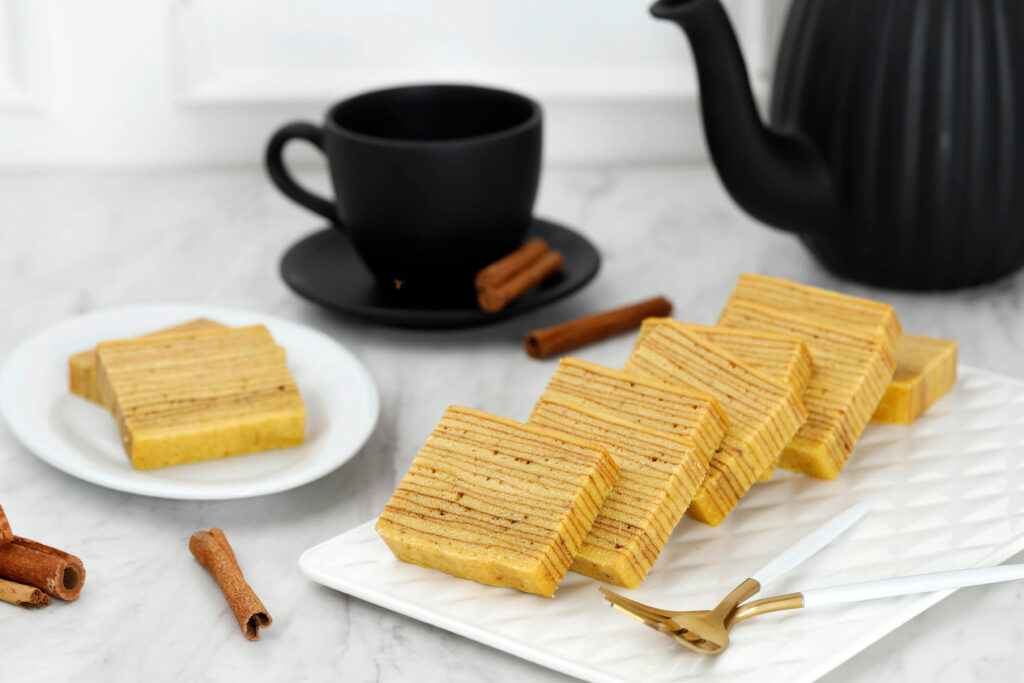
I hope this guide gave you lots of ideas of food items to try on your next trip to the Northlands! Make a list and check each item off as you go to make a little game of it as you travel. Let me know in the comments if I missed any of your favourite foods.
Happy Travels, Adventurers!
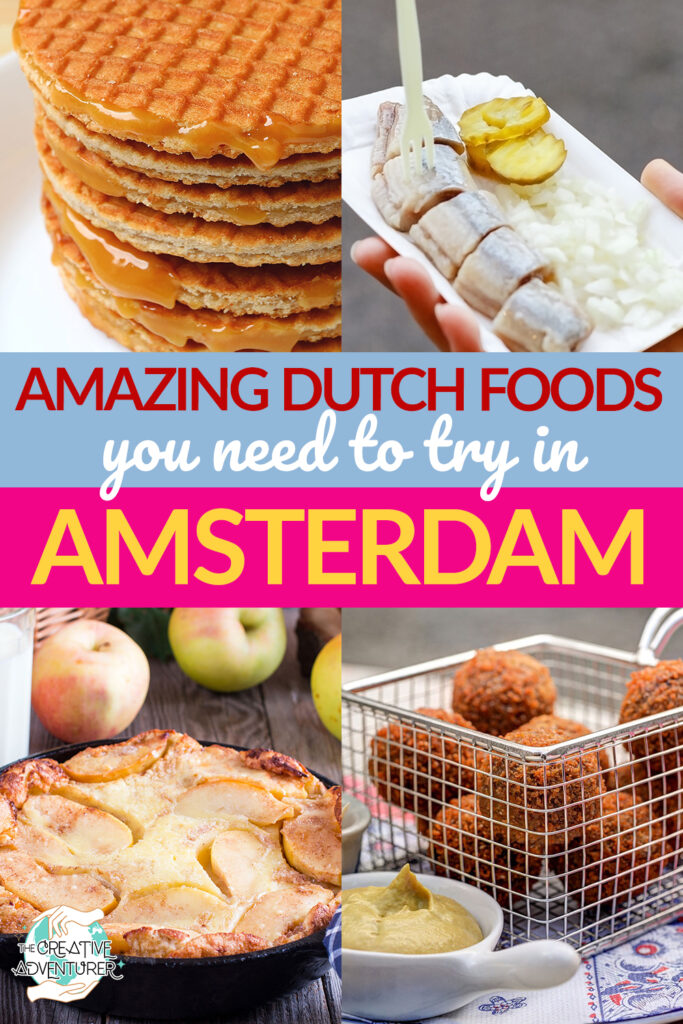
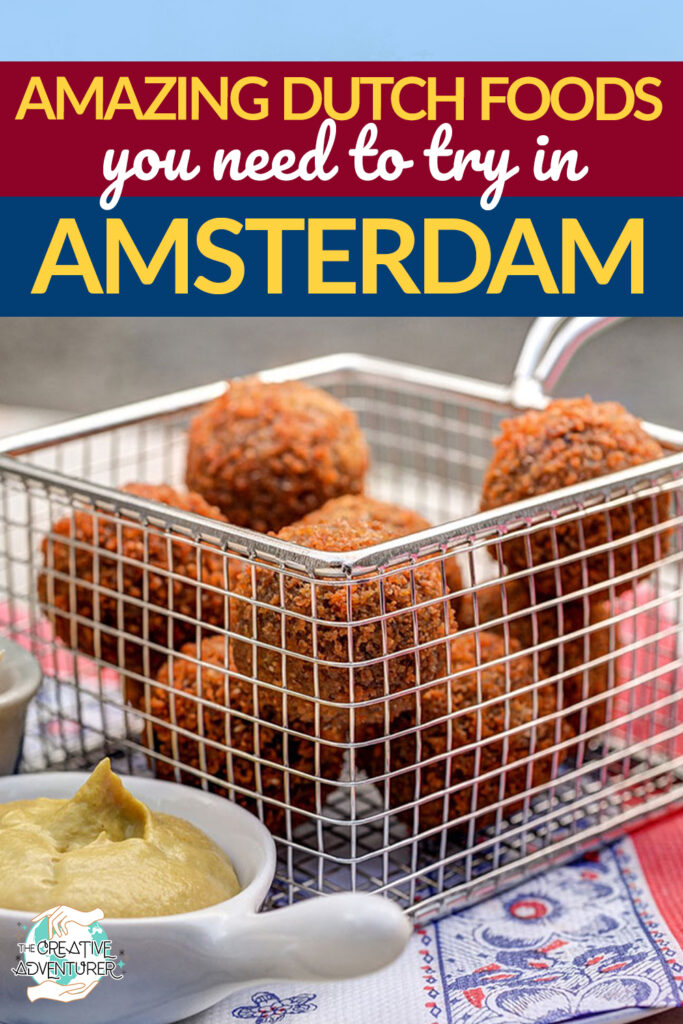


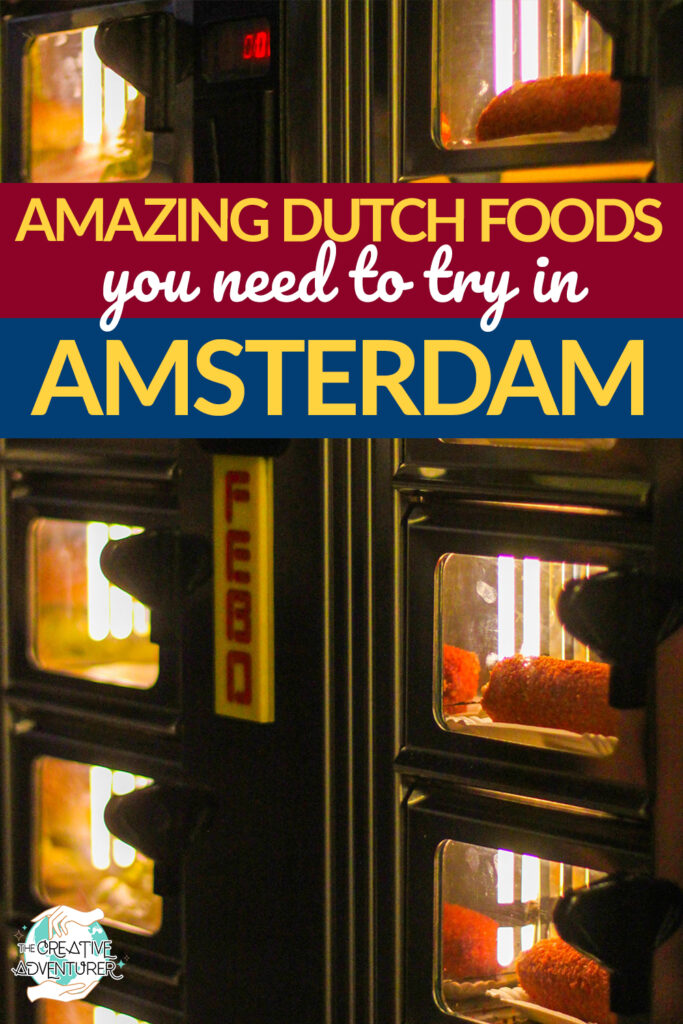
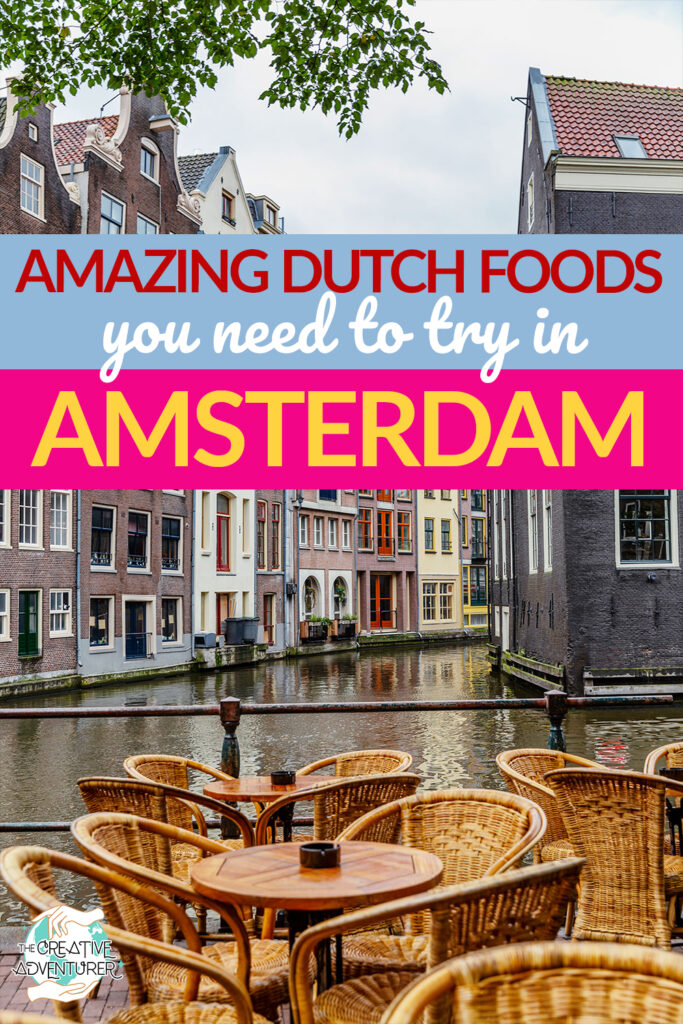


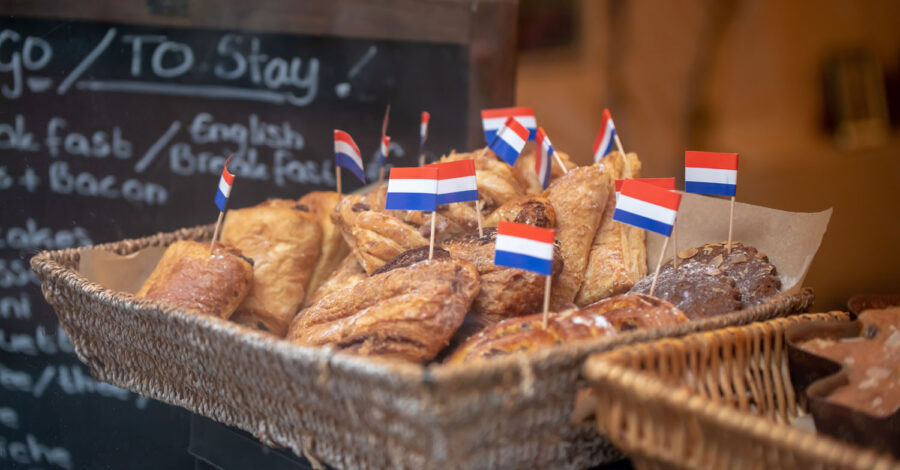



1 COMMENT
Laura
2 years agoHi! As a Dutchie I was suprised at the “in depth” things you put in like Kapsalon, but also Spekkoek and Rijsttafel! Spot on, well done! I just wanted to remark that Amsterdam doesn’t even have 1 million inhabitants, let alone 7 million (NL in total has 17 million). And also the picture accompanying the pannenkoeken section is s picture of “poffertjes”. Which are also typically Dutch and quite tasty.
(NL in total has 17 million). And also the picture accompanying the pannenkoeken section is s picture of “poffertjes”. Which are also typically Dutch and quite tasty.
Anyway, still a great post!
Xoxo,
Laura